Types of Red and White Mushrooms (With Pictures) – Identification Guide
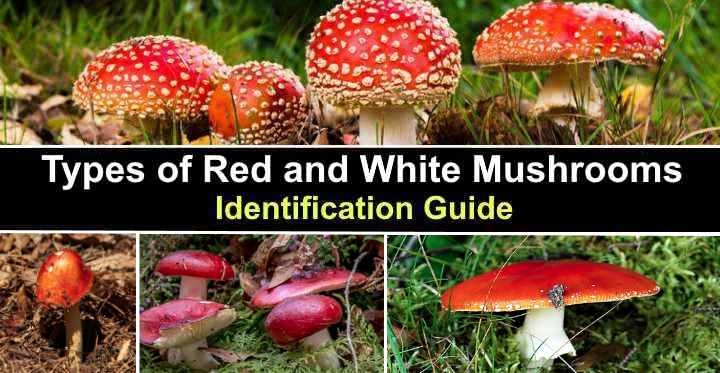
Red and white mushrooms are the most iconic types of mushrooms you will find. Red-capped mushrooms with characteristic white warty spots evoke pictures of enchanted woodlands. However, far from being harmless fungi growing in grassy undergrowth, most red and white mushrooms are poisonous if consumed. Most varieties of red and white mushrooms are in the genera Amanita and Russula.
Red and white Amanita mushrooms grow near conifers and birch trees in mixed woodlands. Most of these orange-to-red mushrooms are easily identified by their white-spotted red caps. Toxic red mushrooms from the genus Russula tend to have smooth dark red caps and white stems. Regardless of the species, you should never consume these mushrooms
The purpose of this article is purely informative to provide visual clues to red and white mushroom identification. It is not meant as a definitive guide for identifying edible and non-edible red mushrooms. However, it’s important to note that you should never eat any type of mushroom without identifying the species 100 percent.
This article contains descriptions and pictures of common red and white mushrooms you are likely to find in lawns, yards, and along woodland paths.
How to Identify Red and White Mushrooms
Apart from the red caps and white stems, there are several identifying features of mushrooms. First, look at the size and shape of the cap and if it has a smooth or bumpy surface. Additionally, look at the underside of the cap to observe the color of the gills. Lastly, cutting open the mushroom reveals the flesh color.
Foraging mushroom experts use these identifying features to tell edible mushrooms apart from poisonous ones. For example, many toxic mushrooms like the red fly amanita have white gills, not brown ones. Additionally, inedible mushrooms typically have a veil ring on their white stems.
When it comes to identifying toxic species of red mushrooms, the presence of white or tan patchy scales is also a sign of their toxicity. However, it’s vital to remember that there are exceptions to the rules when identifying species of mushrooms.
According to researchers, many wild mushrooms are highly toxic and can look like those that appear safe to eat in other parts of the world.
What Are Red and White Mushrooms?
Red and white mushrooms are fruiting bodies of fungi that have a round to flattened red cap and white stem. Mushrooms belong to the Fungi kingdom and reproduce by distributing microscopic spores. Many poisonous red mushrooms have a white stem with a veil-like ring of tissue around it.
Where Do Red and White Mushrooms Grow?
Like the fly agaric, most red and white mushrooms are found on the ground in deciduous and coniferous forests. The fruiting bodies typically grow in dark, shaded places and thrive in damp, warm, humid weather. For this reason, you will typically find red and white mushrooms in shaded woodlands in late summer and fall.
Depending on the conditions, you may also find red and white mushrooms in your yard. Finding these reddish spongy growths is nothing to worry about. Mushrooms are a sign of rich, fertile soil. In addition, they break down organic matter, releasing nutrients back into the ground. However, if you have young kids or pets and you are concerned about poisonous mushrooms, you could remove them and put them in the compost heap.
Types of Red and White Mushrooms (With Pictures) – Identification Guide
Please read on to find descriptions and pictures of the most common types of red and white mushrooms. You will notice that some of these red mushrooms with white stems have similar characteristics.
It’s also good to note that just because mushrooms with a red color can be a warning sign, there are some red edible mushrooms. Additionally, some pure white mushrooms, like the death cap, are highly toxic and should be avoided.
Fly Agaric Mushroom (Amanita muscaria)
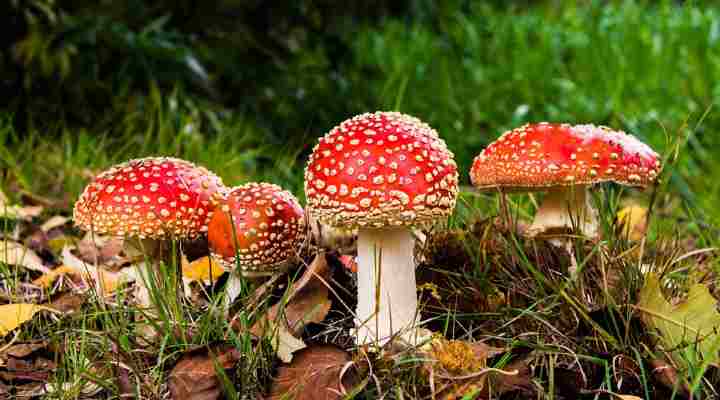
The poisonous fly Agaric mushroom (also called fly amanita) is identified by a red cup with white specs and a white stem
Also called the fly amanita, the fly agaric fungus is a well-known red-capped mushroom covered in white scaly bumps. The easily recognizable mushroom has a rounded bright red umbrella-like cap that gradually flattens as it matures. Under the red and white cap are white gills and a white stem.
In North America, the species of fly agaric is the variety Amanita muscaria var. flavivolvata. This mushroom has similar identifying features to the European native mushroom Amanita muscaria. It has a bright red cap and creamy wart-like growths. However, there are also other variations of fly agaric mushrooms.
For example, the Amanita muscaria var. guessowii is a large poisonous mushroom with a deep orange to yellow cap and white warty spots. This variety of orange mushroom grows near conifers and is commonly found growing from fall through spring.
Fly amanitas are found in temperate regions and start fruiting in late summer and early fall. You will often find the red-capped, white-spotted mushroom near birch trees, pines, and other conifers. It appears later in the season on the Pacific coast, in late fall and winter.
Fly agaric cap
The white-spotted red cap of the fly agaric measures 2.7” to 8.2” (7 – 21 cm) across. The red cap is covered in easily distinguishable white spots. The cap of immature fly agarics is more bulbous and oval or egg-shaped. As the red and white mushroom matures, its cap spreads out, eventually becoming a flattened, red disc and white spots.
Fly agaric stem (stipe)

Fly agaric mushrooms often have skirt-like ring around the stem
The white stem or stipe of the fly agaric mushroom measures 2.7” to 7” (7 – 18 cm) tall and can grow 0.78” to 1.37” (2 – 3.5 cm) thick. Typical of many poisonous mushrooms or toadstools, the stem has a skirt-like ring or ruff around its center.
Other fly agaric identifying features
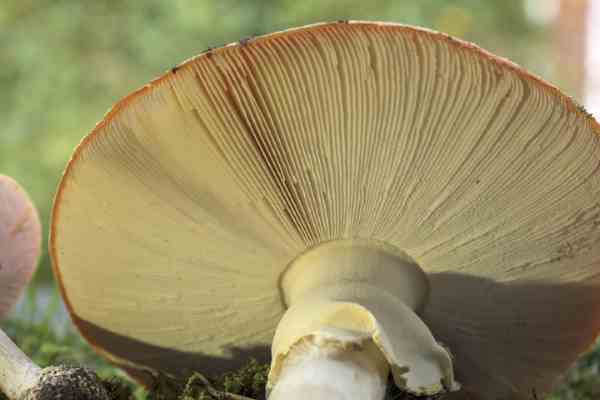
A close up picture of the white gills and skirted stem of fly agaric mushroom
Under the spotted, bright red cap are white gills closely spaced together. These white gills are only attached to the cap, not the stem. The mushroom also has white spores and white flesh and no distinctive odor.
Where does the fly agaric mushroom grow?
The fly amanita mushroom typically grows in deciduous forests or mixed coniferous ones. It starts fruiting in late summer and early fall when temperatures are relatively warm, and there has been heavy rainfall. Although uncommon, the red and white mushrooms can grow in yards and lawns.
Fly agaric toxicity
The distinguishing features of its rounded red cap and white spots make this toxic amanita mushroom easy to spot. In addition, the mushroom contains psychoactive chemicals that can induce hallucinations. Doctors say that symptoms from ingesting fly agarics can be dizziness, confusion, paranoia, and, in severe cases, coma and respiratory failure.
It’s vital to note that poisonous fly agaric mushrooms can look like edible puffball mushrooms when immature. Also, heavy rain can wash away the white warty growths, making the mushroom similar in appearance to the edible Caesar’s mushroom (Amanita caesarea).
Red and white mushroom identification
Identifying the red and white fly agaric mushroom is simple. Look for the characteristic red cap covered with white scaly growths. Fly agaric mushrooms have white flesh, gills, and characteristic shaggy rings around the thick white stipe. It has no distinct smell. The mushrooms grow under beech, pine, and spruce trees.
The Sickener Mushroom (Russula emetica)
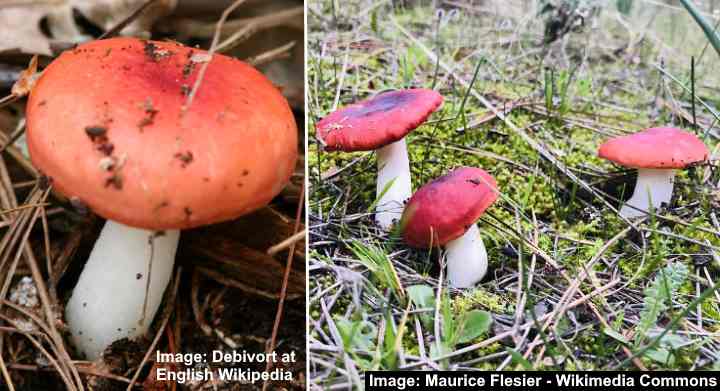
The poisonous sickener mushroom can be identified by its red sticky cap and white stem and can be found in forests or near coniferous trees
The sickener mushroom is a large flat-topped mushroom with a vibrant pinkish-red cap and thick white stipe. Depending on its growth, the bright red cap may have an indentation in the center, giving it a saucer-like, sometimes vase-like appearance. Under the red cap are white, widely-spaced gills, and its brittle stalk has pure white flesh.
Identifying specifications of the sickener mushroom are as follows. Its round, flat, convex cap measures 1” to 3.3” (2.5 – 8.5 cm) in diameter. Its white stalk is 1.8” to 4.1” (4.5 – 10.5 cm) tall and up 0.3” to 1” (0.7 – 2.5 cm) thick. Additionally, its cherry red cap is sticky to the touch.
As its name suggests, Russula emetica is a poisonous species. The scarlet-red sickener mushroom gets its name because it causes nausea, vomiting, diarrhea, and abdominal pain. This is why it’s also called the emetic russula or vomiting russula.
This mushroom is commonly found growing on moss in coniferous forests. It can also be found fruiting on rotting logs.
There are several red and white mushrooms related to the sickener mushroom. However, they all have similar characteristics — a bright red cap and thick, white smooth stem.
Red and white mushroom identification
The identifying features of the sickener mushroom include a bright red cap with a central depression, white stem and flesh, closely-spaced gills, and a sticky feel to its cap.
The Beechwood Sickener Mushroom (Russula nobilis)
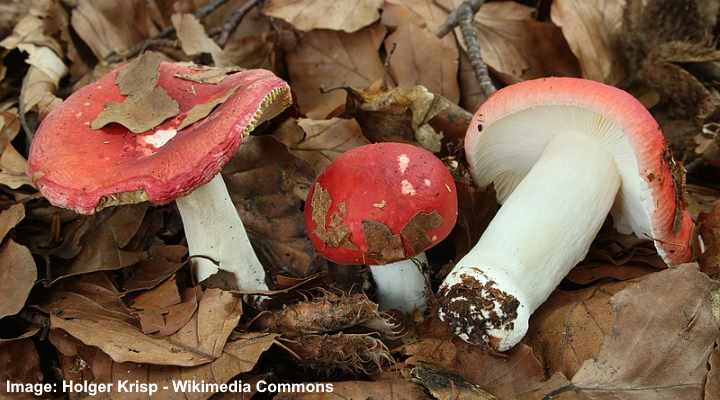
The toxic beechwood sickener mushroom has a red cap, tightly white spaced gills and white stem, and is typically found near beech trees
The beechwood sickener mushroom is a medium-sized mushroom with a bright, rosy-red cap, convex shape, smooth white stem, and coconut-like aroma. It also has yellowish-white flesh and narrowly-spaced gills. This bitter-tasting red mushroom is considered poisonous but not deadly.
The round, flattened cap of the beechwood sickener mushroom measures 1.18” to 2.36” (3 – 6 cm) wide. Its white stem measures 0.78” to 2” (2 – 5 cm) tall and up to 0.6” (1.5 cm) thick. You can sometimes notice a faint blue-green sheen on the narrowly spaced gills.
As its name suggests, this toxic red mushroom is typically found near beech trees. Additionally, ingesting this red and white mushroom can result in gastrointestinal upset — stomach pains, diarrhea, nausea, and vomiting. It’s said that boiling reduces its toxin levels. However, this poisonous toadstool should not be eaten.
There are no distinguishing features between this Russula species and other bright red-capped mushrooms in the same genus.
Red and white mushroom identification
To identify the beechwood sickener mushroom, you must look for its bright red cap, convex shape, and smooth white stem and gills. The red and white mushroom typically grows under beech trees and can also grow in mixed forests.
Ringless False Fly Amanita Mushroom (Amanita parcivolvata)
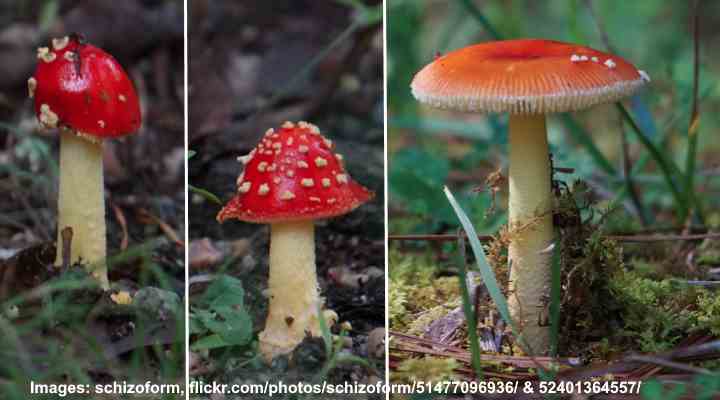
The ringless false fly amanita mushroom has a red or dark orange cap with few white specs and can be similar to the fly Agaric mushroom
The ringless false fly amanita mushroom is a small, brightly-colored red-capped mushroom with flaky white spots and a relatively smooth white stalk. Under the sticky red cap are densely growing creamy-white gills distributing white pores. Because of its appearance, it’s easy to confuse it with the fly agaric mushroom (Amanita muscaria).
The ringless false amanita mushroom has a convex to broadly convex flat cap, sometimes with a shallow depression. The orangish-red cap is covered in white to yellowish patches. The cap measures 1.1” to 2.7” (3 to 7 cm) in diameter.
A way to tell the ringless false fly amanita from Amanita muscaria is by its slenderer stem. The slender cylindrical white stem measures 1.5” to 4.7” (4 – 12 cm) long and 0.6” (1.5 cm) thick.
You will typically find this red and white mushroom species growing near species of oak trees. It is also a common lawn mushroom that thrives in grassy areas like parks, disturbed areas, pathways, and woodlands. In addition, it can be found on the ground under various types of conifers.
Red and white mushroom identification
The ringless false fly amanita mushroom has an orange-red cap with white spots covering its surface. Its slender white stem has a slightly rough texture and lacks the veil-like stem ring of other toxic red and white mushrooms. This poisonous mushroom is easily confused with fly amanita mushrooms.
Rosy Russula (Russula rosea / Russula lepida)
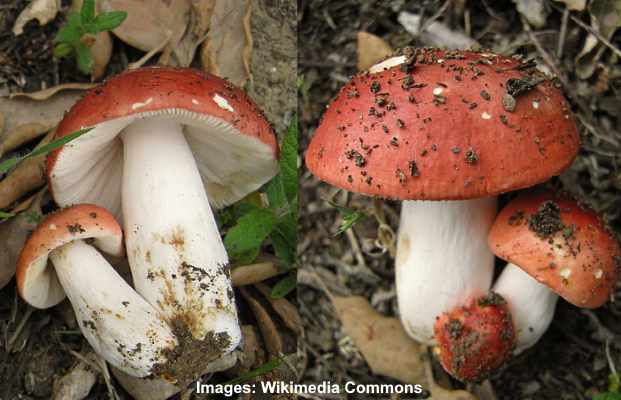
The red and white rosy russula mushroom has a robust stem and is similar to other species of russula mushrooms
The rosy russula mushroom is a large mushroom with a bright pinkish-red cap, pale cream brittle gills, and a robust, cylindrical stem. The umbrella shape of the carmine red cap tends to flatten as it matures. In some species, you’ll notice a creamy patch toward the center, which is sometimes indented.
The rosy russula red and white mushroom has a cap measuring 2” to 4.7” (5 – 12 cm) in diameter. The rounded, convex cap has a slight depression at the center. The cap can have a shiny appearance but sometimes can be matt with a fine powdery coating.
The solid, brittle stem of this rosy-red-capped fruiting fungus measures 1.5” to 4” (4 to 10 cm) tall and 0.4” to 0.8” (1-2 cm) thick. It also has creamy-white gills and pale-cream spores.
This red and white rosy russula mushroom is commonly found near beech trees and other deciduous broadleaf trees. However, it can grow in mixed and coniferous forests.
Red and white mushroom identification
The rosy russula is similar looking to other species of russula mushrooms. It has a pinkish-red rounded cap that flattens with age, has pale gills, and sits on a thick white stem.
Related articles:
- Types of Lawn Mushrooms – Identification Guide
- Orange Mushrooms – Identification Guide
- Types of Edible Mushrooms
